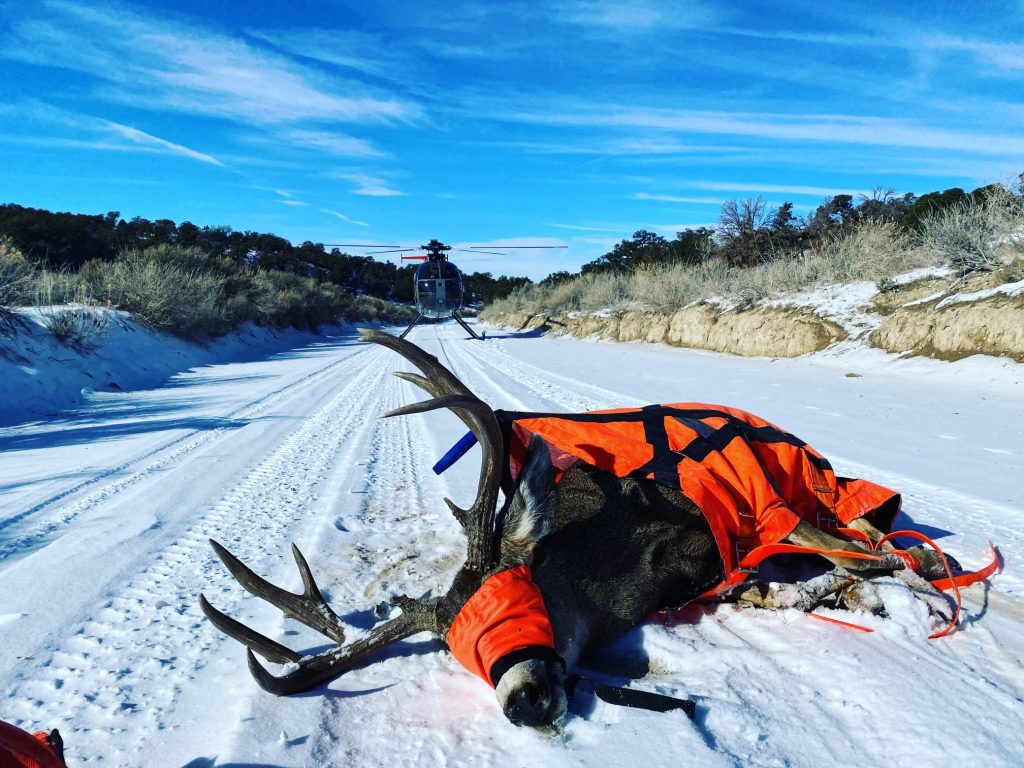A Mule Deer ready to be lifted to a place where veterinarians can check the health of the animal.
HYRUM – Each year the Utah Division of Wildlife Resources captures and analyzes deer for their health at Hardware Ranch and other locations around the state. They also capture and analyze other game.

For the past 10 years they have contracted with Helicopter Wildlife Services, a South African company owned by Mike Ross. The company spends October to April in the U.S. safely taking thousands of wildlife. From April to October, they capture wildlife in Southern Africa.
The company has been operating in South Africa for over 31 years and in the U.S. 15 years.
Besides the net gun approach they used on Utah’s Mule Deer, the company also uses chemical capture and corral capture methods. Mule Deer are only one of the species captured and handled in North America.
Helicopter Wildlife Services captures wildlife as small as the Blue Duiker African antelope, generally under 16 inches high to the shoulder and weighs less than 20 pounds, to an elephant weighing thousands of pounds.

Kent R. Hersey, the big game manager for DWR, said for over a decade Wildlife Capture Services has been grabbing big game in Utah. They have proven to be an impressive company to work with.
“Wildlife Capture Services people are highly professional and good at what they do,” he said. “Mike was a big game hunting guide before he started flying to capture animals. He knows his animals.”
Right now, the crew is in Texas working with wildlife officials there. Their equipment includes two MD 500 Helicopters and several net packages. They have a crew of four.
Ross has good things to say about working for DWR.
“Utah is a fantastic state to work with,” he said. ”We actually like working with the DWR people.”
Ross is passionate about wildlife capture and believes in his professional abilities as a wildlife capture pilot and operator.
One crew member drives a fuel truck, one, sometimes two are net gunner/mugger and there is the pilot. The net gunner/mugger shoots the net then gets the animals blindfolded, hobbled and ready for flight.

The capture service works for both state and federal agencies as well as private companies and organizations.
“It’s dangerous. We do a lot of training,” Ross said from his Texas camp. “We work in snow, mist, rain, and wind. We have never had a serious injury…knock on wood.”
They wrecked two helicopters in Utah over the years, one in the La Sal Mountain range while they were catching mountain goats, the other near Strawberry Reservoir catching elk. Both times they escaped serious injury.
“Our capture personnel are trained and experienced in all services we offer,” he said. ”We have a high standard of safety and utmost consideration for the welfare of the animals that we capture and handle.”
There are not a lot of companies doing this kind of capture work. There are only two or three others in the United States.

Working in both North America and Southern Africa allows Ross’ team to catch a wide range of species, from small fragile game like wild turkeys to truly big game such as buffalo and giraffe, as well as highly endangered and sensitive species like bighorn sheep, mountain goat, black and white rhino.
“The only thing I haven’t captured is bear,” he said. “They are generally hibernating when I’m in the U.S.”
In the name of conservation, Ross’ team has caught various species of wildlife that live in ranges from the high altitude, mountainous terrain in Utah, extreme cold temperatures of Northern Michigan, South Texas brush country to the different topographies found in Southern Africa.

